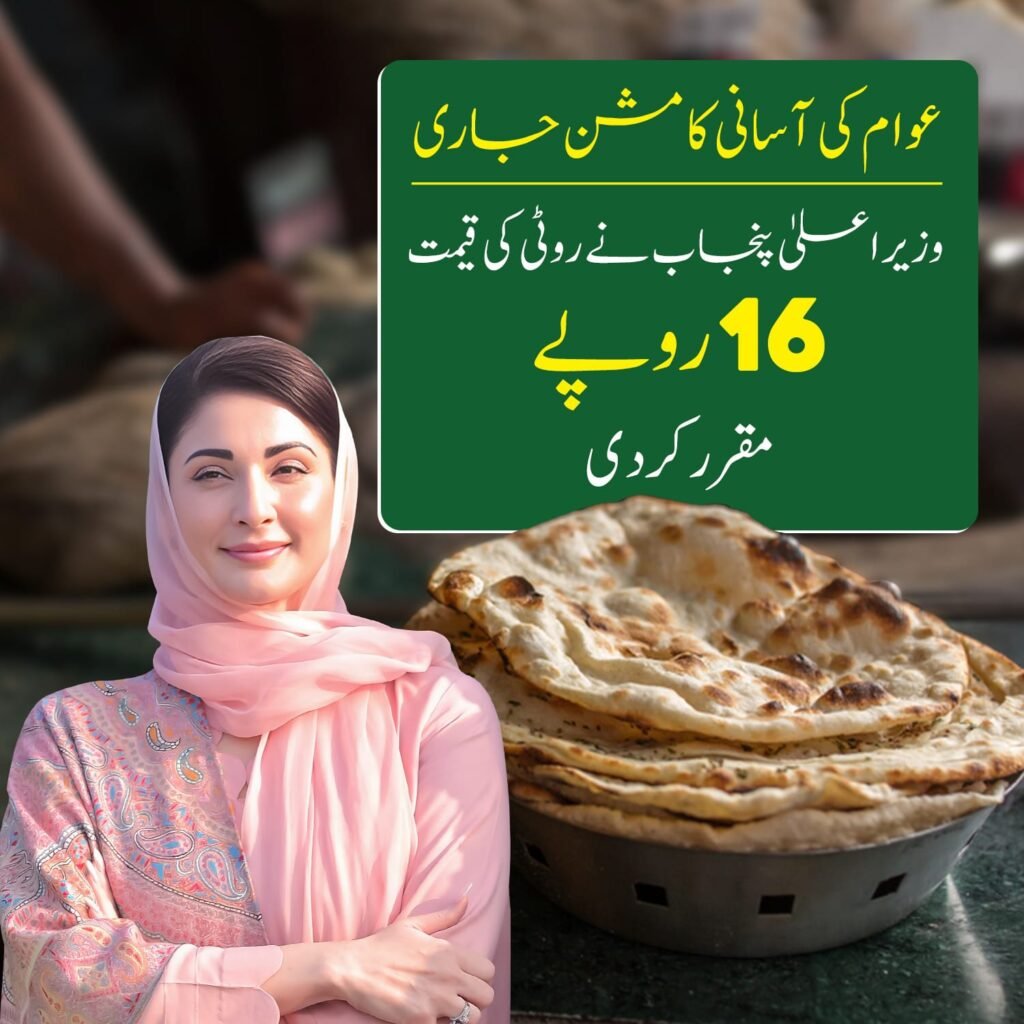CM Punjab Maryam Helpline for Sasti Roti and Naan
The Pro-Poor Decision by Chief Minister Punjab, Maryam Nawaz Sharif, on the Price of Roti and Naan announced on 14th April 2024. Under the directives of the Chief Minister of Punjab, Maryam Nawaz Sharif, the Deputy Commissioner of Lahore, Rafia Haider, has issued a notification setting new prices for roti and naan.
According to the spokesperson for the DC Lahore, the price of 100 grams of roti has been set at 16 PKR, while a 120-gram naan will cost 20 PKR. This decision aligns with the provisions of the Punjab Price Monitoring for Essential Items Ordinance 2023, specifically clauses five (3), (4d), and six. Also Check CM Punjab Contact Number for Education Department.
The new pricing policy will be immediately applicable across the district. The adjustment in prices was made following recommendations from the Food Department, considering the improved wheat harvest and the stability in supply and market prices.
The spokesperson for the DC Lahore urged the public to report any discrepancies in the pricing of roti and naan at any location by contacting the hotline number 080002345.
This initiative reflects a commitment to ensuring affordable food items for the economically disadvantaged sectors of society, demonstrating a direct effort by the provincial government to support the needs of its citizens effectively. This move is part of a broader strategy to monitor and control the prices of essential commodities, safeguarding the interests of the poor against undue price hikes and economic hardship.

Benefits of CM Punjab Maryam Helpline for Sasti Roti and Naan
The implementation of a dedicated helpline (080002345) for reporting issues related to the pricing of roti and naan under the new pricing policy in Punjab, Pakistan, introduces several strategic benefits that enhance the effectiveness and reliability of the initiative. Here are the key advantages of having this helpline:
Enhanced Enforcement: The helpline provides a direct channel for the public to report non-compliance with the set prices. This facilitates quicker governmental response and enforcement, ensuring that the pricing guidelines are adhered to across the region.
Increased Accountability: With a dedicated number for grievances, vendors and retailers are more likely to adhere to the official pricing out of accountability. Knowing that consumers can easily report violations increases compliance among sellers.
Consumer Empowerment: The helpline empowers consumers by giving them a tool to voice their concerns and report any discrepancies or unfair practices they encounter. This empowerment helps build consumer confidence and trust in the system.
Rapid Response and Problem Resolution: The helpline allows for the swift identification and resolution of issues related to the pricing of essential food items. Rapid responses can prevent minor issues from escalating into more significant problems, maintaining the stability of food prices in the market.
Data Collection and Insights: Calls and reports made through the helpline provide valuable data about where, how often, and what type of violations occur. This data can be used to improve policy implementation, understand market dynamics, and adjust strategies if necessary.
Public Education and Communication: The helpline serves as a resource for education and communication to the public about their rights and the government’s efforts to control food prices. It can be used to inform and educate the public about why price controls are in place and how they benefit the community.
Building Trust in Government Initiatives: By demonstrating a commitment to enforcing and monitoring its policies, the government can build greater trust among the citizens. This trust is crucial for the success of any public policy, particularly those affecting daily necessities like food.
Preventing Exploitation and Inflation: The helpline indirectly helps prevent exploitation by vendors who might otherwise increase prices based on demand or other factors. It also aids in controlling inflationary pressures on basic food items, contributing to overall economic stability.
Resource for Vulnerable Populations: For individuals in vulnerable economic conditions, knowing there is a helpline available provides a sense of security that there are mechanisms to protect them from overpricing and exploitation.
Transparency in Governance: Finally, the helpline increases the transparency of governmental operations. It shows an open, responsive government willing to engage directly with its citizens to address their needs and enforce laws intended to protect them.
